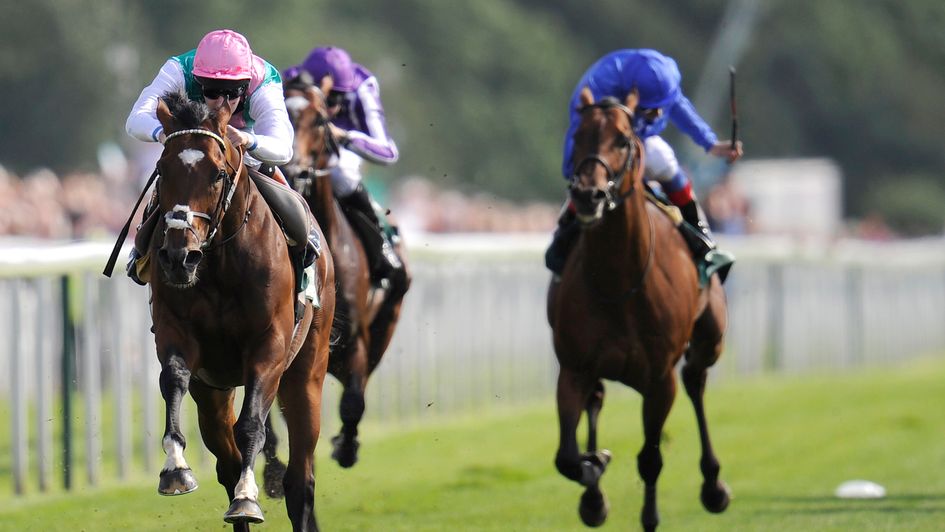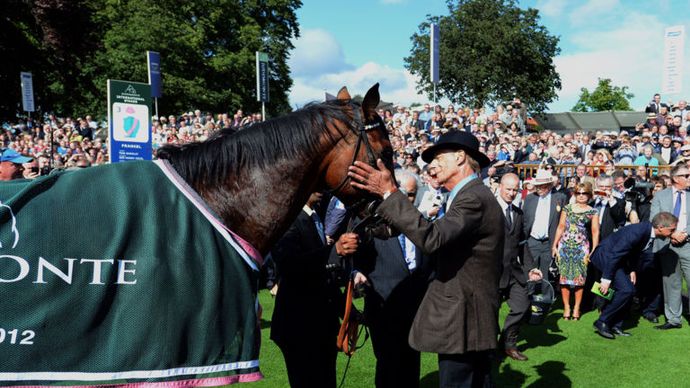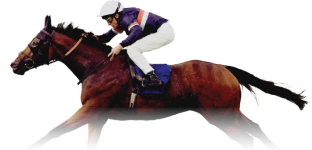We look back on the day Frankel strutted his stuff at York Racecourse in the August of 2012, when he sauntered to a sensational win in the Juddmonte International.
Nearly nine years have now passed since Frankel won the Juddmonte International, where he put up one of the very best performances of his career in one of the flagship races of York’s Ebor Festival.
Frankel had already proved himself to be an outstanding racehorse long before his eagerly-anticipated visit to the Knavesmire. His winning sequence stood at 12 races, including eight Group Ones, and just two starts earlier he had won the Queen Anne Stakes at Royal Ascot by 11 lengths. That performance earned Frankel the highest Timeform rating ever on the Flat, with his figure of 147 surpassing the rating Sea-Bird achieved when winning the 1965 Prix de l’Arc de Triomphe by 2lb.
The International provided Frankel with a fresh challenge as he stepped up to an extended mile-and-a-quarter for the first time in his career having previously raced exclusively at up to a mile.
Despite the question marks about his stamina, Frankel started at 10/1-on, with his biggest danger looking to be the Breeders' Cup Turf and dual Coronation Cup winner St Nicholas Abbey, one of three Ballydoyle runners, who was sent off second favourite at 5/1, with Farhh and Frankel's stablemate Twice Over (winner of the race the previous year) the only others at shorter than 20/1.
The marketing build-up – featuring adverts on Yorkshire Television “Come and see Frankel, the greatest horse in the world” – contributed to a clamour for tickets for what York's Chief Executive William Derby described afterwards as “the most memorable day we have ever had here”.
There had, he said, never been so many cars parked on the Knavesmire – the approach roads were jammed before racing – and the crowd of 30,163 was fifty per cent up on the same day the previous year (19,457 in 2011).
As racegoers packed in around the paddock to get a sight of Frankel, the emotionally-charged atmosphere was heightened by the sight of his trainer, Sir Henry Cecil, looking gaunt and walking with the aid of a stick amidst ongoing treatment for stomach cancer.
Cecil was determined to be on a racecourse again after missing Frankel’s second win in the Sussex Stakes three weeks earlier, while Frankel's owner Khalid Abdulla was at York, too, after missing Frankel's appearances at Royal Ascot and Goodwood.
Entering the paddock with a police escort, Frankel looked well muscled up and very fit. He never turned a hair, either in the paddock preliminaries or going to post. A fluent mover, Frankel floated over the ground on the way to the start and he proved a class apart from his rivals in the race itself, recording one of his finest victories, one that will have left an indelible mark on the memory of those who witnessed it.
Incidentally, the number of Channel 4 TV viewers and the audience share were both up by over 40 per cent, the 845,000 who were watching equivalent to a 12 per cent share of the terrestrial TV audience at the time.
Ridden as patiently in the International as in any race since his two-year-old days, Frankel slipped through quickly from the rear soon after the runners had turned into the home straight, steered towards the stand rail by a motionless Tom Queally. He took up the running on the bridle around two furlongs out, after cruising up alongside St Nicholas Abbey, who had also been waited with and had himself yet to be asked a serious question after moving very smoothly into contention.
Farhh had also travelled well from the start in a truly-run race (the pace set by the Ballydoyle pacemakers), but neither he nor St Nicholas Abbey was able to go with Frankel once he produced his now-customary burst, after one tap with the whip, to go clear with over a furlong to go.
Ridden out only with hands and heels, Frankel was value for more than the seven lengths by which he beat very close finishers Farhh and St Nicholas Abbey, with Twice Over coming six lengths further back in fourth.
The reception Frankel received from the Yorkshire crowd was rapturous as his jockey trotted him down in front of the stands before returning to the unsaddling enclosure. As well as recording another performance that merited a Timeform rating of over 140, Frankel earned a timefigure of 136, the fastest of the twenty-first century.
Frankel was his trainer's fourth winner of the International and in a post-race interview – his cancer treatment having left his voice faint – he said “That was great, wasn't it? It's fantastic. It's great for Yorkshire. They are very supportive of racing and they deserve to see him.”
Anyone fortunate enough to be at York to witness Frankel’s victory in the Juddmonte International was certainly grateful of the opportunity to see him in action. Here a selection of contributors provide their recollections of that memorable day…
James Brennan – Head of Marketing and Sponsorship at York Racecourse
As a racecourse team we often talk about being in the “business of making memories” and boy did Frankel deliver on that score. The buzz in the lead up to the race and its aftermath was electric.
I remember the 30,000-strong crowd fell virtually silent as the commentator intoned “Frankel sits in last position as they look to make the turn” and then they erupted as he stretched away when passing them.
The poignant moment when a Yorkshire accent called for “three cheers for Sir ‘enry” as he collected his trophy will stay with me for a long time.
Graham Cunningham – Racing UK pundit for Frankel’s International win
The sight of Frankel and Tom Queally making world-class horses look like selling platers at York is one of the most mesmerising things I’ve ever witnessed on a racecourse.
And yet the towering brilliance of that 2012 Juddmonte International success was only the second most powerful image of a historic day.
The York paddock was packed inside and out and, working from the Racing UK pitch, Nick Luck set the scene as I scanned the throng for the man behind the equine masterpiece.
An elegant brown tweed blazer with blue shirt and silvery grey tie was a sober choice of outfit by Sir Henry Cecil standards.
A jet-black trilby akin to the one worn by Robert Redford’s Sundance Kid added a suitably dramatic flourish, but the dark walking cane that completed the ensemble was the giveaway.
Cecil had been timing gruelling chemo sessions to fit Frankel’s training programme and, having missed his stable star’s second Sussex Stakes success three weeks earlier, he cut a haunted figure as old and young eyes turned his way.
But the emaciated old showman was all business as he delivered instructions to Queally, Ian Mongan (Twice Over) and Eddie Ahern (Bullet Train), who gazed up like rapt schoolboys at a man who was plainly treading the boards on borrowed time.
Queally was legged up with a final whispered word. Cecil paced to his usual place in the grandstand. And Frankel took the Knavesmire stage by storm, scything through to challenge the high-class Farhh and St Nicholas Abbey then powering seven clear to send his adoring public into raptures.
“You’ve seen it, now try and believe it,” was Lucky’s instant summary as Queally prepared to parade his peerless partner back past the heaving grandstands.
Anxious to do the occasion justice, I followed up with “Halley’s Comet comes around every 75 years, a horse like Brigadier Gerard comes around every 40 years, but a horse like this comes around once in centuries.”
Two months on, Frankel completed a flawless 14-race career in Ascot’s Qipco Champion Stakes. Ten months on, Cecil’s cancer claimed him. And almost a decade down the track, memories of Frankel’s sole York foray remain vivid as his sons and daughters excel.
There has never been a horse quite like Frankel and there has never been a trainer remotely like Sir Henry.
One waxed as the other waned during that spectacular summer of 2012. But in those magical minutes at York, they combined to deliver something that may never be matched in its poignancy and perfection.

Simon Holt – Channel 4 commentator for the 2012 Juddmonte International
Next week's Juddmonte International has in many seasons been the highest-rated horse race in the world, but it is hard to believe there was a better renewal than in August 2012 when the great Frankel came to York.
Unbeaten in 12 previous starts and arriving on the back of wide-margin wins in the Lockinge Stakes, the Queen Anne Stakes and the Sussex Stakes, the country's champion racehorse proved a massive draw with excitement, in what turned out to be his penultimate race, heightened by the fact he had never previously run beyond a mile.
In the early part of his three-year-old career when Frankel's extraordinary talent overcame a strong-pulling, profligate style of racing in races like the 2000 Guineas and St James's Palace (in which he nearly got beaten), it would have been inconceivable that he should be tried over a longer distance despite the clamour (at the time) that he should take his chance in the Derby.
But, as a four-year-old, the horse that could reputedly run faster than passing trains on the Newmarket gallops, had become much more professional and, under the guidance of his brilliant trainer Sir Henry Cecil, could now be switched off the pace and ridden with great confidence by regular rider Tom Queally.
Still, there were plenty who doubted whether a horse who could put in multiple sub-11-second furlong splits would have the stamina for an extended mile-and-a-quarter up against such luminaries as St Nicholas Abbey and Farhh.
Arriving on race-day to call for Channel 4, I was surprised to see a few people one would not normally associate with Flat racing in the car park; one was the jumps trainer Henry Daly.
More commonly sighted in tweed or colourful corduroy trousers at Ludlow and Bangor-On-Dee, I asked Daly: “What on earth are you doing here?” to which he replied in the company of young children: “We wouldn't want to miss this.”
Just before the race, the packed stands resonated with that low hum unique to really big sporting occasions, an atmosphere I have experienced on only a few occasions including before Best Mate's attempt at a third Cheltenham Gold Cup and when Black Caviar, ‘the wonder from down under’, ran at Royal Ascot.
The anticipation was certainly unlike any other race in my time commentating at York and, as the field turned into the home straight, Queally was just tracking his main rivals though some way behind the pacemakers.
What happened next was quite extraordinary as, switched out towards the stands side rail, Frankel made up ground effortlessly and, barely coming off the bridle, he swept past St Nicholas Abbey and Farhh as if they were selling platers to win easily by seven lengths.
Afterwards the cheers rang out long and loud for this unbelievable racehorse, but also for Cecil who dressed in black, cut a pale and gaunt figure as a result of his battle with stomach cancer which nevertheless hadn't prevented him from devouring two lobsters at lunch.
In a barely audible whisper, he claimed that Frankel was “the best I've ever seen, perhaps the best there ever will be” before emotionally accepting his trainer's prize.
In any assessment of Frankel's exceptional career – he would retire 14 not out in the Champion Stakes at Ascot two months later – it is valid to suggest that, given how spectacularly well he stayed at York, perhaps he should have run in the Arc.
I doubt he would have had any trouble staying a mile and a half as a four-year-old and the performances of his progeny add some support to this view.
But there can be no questioning his claims on greatness when you consider the horses he extinguished and what they also achieved.
After York, St Nicholas Abbey won the Dubai Sheema Classic and a third Coronation Cup the following year. Farhh went on to win the Lockinge and the Champion Stakes.
Frankel's regular whipping boys Excelebration and Nathaniel won multiple Group Ones. After being thrashed 11 lengths in the Queen Anne, Excelebration was an impressive winner of the Prix Jacques le Marois and Queen Elizabeth II Stakes. Nathaniel, beaten narrowly by the great horse on his debut, won the King George and the Eclipse.
On his final start in the Champion Stakes at Ascot, Frankel beat the hugely popular French gelding Cirrus Des Aigles, who won four more Group Ones subsequently, with Nathaniel finishing a well beaten third.
Thus, there can be no disputing this unbelievable racehorse's legacy but, while he was outstanding in the Queen Anne, I still think his performance at York was even better, a day when a passionate Yorkshire crowd (plus a few surprise visitors) witnessed something they may never see the like of again.
Competition: Win York Ebor Tickets
Answer this question for your chance to win a pair of tickets to the Thursday (August 19) of the York Ebor Festival.
Just log-in or register for a FREE Sporting Life account to enter.
Competition closes Friday August 13 at 1700 BST. See full entry instructions and our competition terms and conditions here.
Adam Houghton – Fan turned Sporting Life/Timeform writer
The summer of 2012 was a significant time in my life for a couple of reasons. For a start, it was that September that I went off to university, taking my first big step towards what I hoped would be a long and successful career in racing journalism.
The second landmark moment of that summer had already been and gone the previous month. Indeed, as I headed off to my new digs in Newcastle, I did so fully in the knowledge that, no matter how long I might be lucky enough to be involved in racing, I would probably never get the opportunity to see another horse who could be mentioned in the same breath as the one who had strutted his stuff so majestically in the Juddmonte International at York’s Ebor Festival.
For a racing-obsessed teenager who had spent hours growing up reading about the likes of Sea-Bird, Nijinsky and Brigadier Gerard, Frankel had already gripped my imagination long before he ever stepped foot on the Knavesmire, quickly realising that this was a horse soon to join them in the pantheon of greats.
I had travelled far and wide over the course of the two previous seasons to see Frankel in the flesh, but the opportunity to see him in action at York was something different and infinitely more special. After all, I was born and grew up within eight miles of the course and it was afternoons spent on the Knavesmire where my love for the sport had first flourished.
Even now when I go racing you will find me at the pre-parade ring with camera in hand before a big race, clicking away to populate the many albums I have which will hopefully help me to recall such momentous days in later life. Special provisions had to be taken for Frankel’s visit to York.
My memory is already hazy when it comes to who won the Acomb or the Great Voltigeur earlier on the card as I didn’t watch either race live, preferring to guarantee myself a place at the pre-parade ring long before Frankel strode in.
I was far from alone and, shortly after the Great Voltigeur had been run – Thought Worthy the winner for anyone still wondering – the numbers around me swelled to levels like I had never seen before at York, seemingly around 10-deep with many of the onlookers no doubt bemoaning the lanky teenage who had secured pole position.
As for the race itself, I distinctly remember Stewart Machin’s early commentary when he said that Frankel had been “put to sleep” by Tom Queally, largely due to the hysterical reaction of the friends I was with. “I hope not!” they all cried in unison before bursting into fits of laughter.
Machin’s point was an important one, of course, and it became clear from an early stage that Frankel had settled beautifully on his first try at a mile and a quarter. And, when Queally unleashed him in the straight, the race was over in a flash, just like virtually every other race in which Frankel was in involved. Daylight followed the flash before his toiling rivals eventually completed the race, led home by Farhh and St Nicholas Abbey, both top-class performers in their own right.
A good position to welcome Frankel into the winners’ enclosure proved harder to come by than it had been at the pre-parade ring, but I was still close enough to hear the three cheers ringing out for his trainer, Sir Henry Cecil.
I hadn’t caught my last glimpse of Frankel for the day, either, as I briefly caught up with him on his journey back across the Knavesmire to the stable yard, exiting the racecourse through the area where there is now a Frankel statue as well as gates erected in honour of Sir Henry Cecil.
Those monuments will help to ensure that both man and horse are never forgotten at York, but that was unlikely to happen to anyone who was lucky enough to be there on that August afternoon anyway. I know I certainly won’t, with pictures from my vigil at the pre-parade ring to make sure of it.











